
by Elizabeth Atalay | Nov 6, 2013 | 2013, Africa, Education, Social Good, World Moms Blog, World Voice, Younger Children
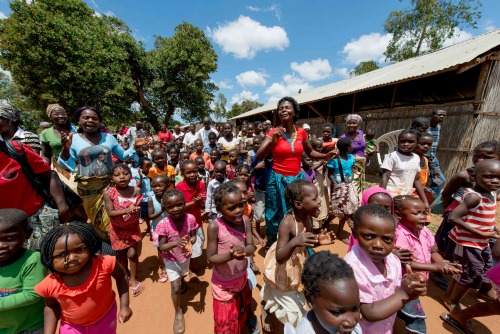
Singing and dancing is the order of the day as this procession of Save the Children preschool graduates, teachers and community members in Mozambique’s Gaza Province makes its way across the school ground to the nearby primary school, where the little graduates will be studying next year. Photo credit: Pei Ketron for Save the Children. October 2013.
In a newly published preschool programs are described as a promising policy option for improving the school readiness and later success of poor and disadvantaged children in rural Africa.
Tonight at 9pm EST World Moms Blog will join Save The Children and Multicultural Kid Blogs at #Moms4MDGs to discuss the importance of early education, and as a specific example, the success of the Save The Children preschool program in Mozambique. Ajla Grozdanic of Save The Children recently returned from a site visit to Mozambique and the early education programs there. She shared her insight in an interview with World Moms Blog as a lead up to tonights Twitter party:
World Moms Blog: In a Chicken & Egg sense, are early education programs only able to be initiated in areas where some basic infrastructure is already in place, i.e. access to clean water, healthcare & nutrition, or are they catalysts for communities to begin to pull out of extreme poverty?
AG: We are able to initiate education programs in communities at any level. In other words, having a basic infrastructure in place is not a pre-requisite for education programs, which can range from in-home daycare to in-school programs.
In fact, early childhood education can bring catalytic change for communities. Early childhood development centers and programs provide an opportunity to reach young children with basic services like healthcare and nutrition, which can be more difficult to deliver if we depended on parents to seek out these services on their own. Early childhood development centers also facilitate community mobilization, bringing parents and other community members together for projects, such as digging wells or cleaning stagnant water that hosts malaria.
Young children naturally learn from and imitate what’s in their environment–good or bad. For this reason, educating young children is key and it fosters the kinds of attitudes and behavior that can improve community well-being over the long term, such as developing good hygiene and healthy eating habits and sharing this knowledge with siblings and neighborhood children.
WMB: Could you explain a bit why Mozambique was a good fit for this program? What is the success rate for other similar early education programs Save the Children runs in other countries?
AG: Mozambique had very low coverage for preschool or early childhood development programs, so the need and demand was high. It’s also important to note that the local communities demonstrated an openness and eagerness to engage in these issues. Communities saw the potential and agreed to invest in their young children. Once they saw the results, which were very good, the word spread and the demand grew.
The World Bank Study, which is the first such evaluation of early childhood development programs in Africa, showed that children in rural Mozambique, who attended Save the Children’s preschool programs, were 24 percent more likely to enroll in primary school and were significantly better equipped to learn than children not covered by the program. While we haven’t had the funding to conduct similar studies in other countries where we offer such programs, our own results monitoring shows a similar success rate across the board.
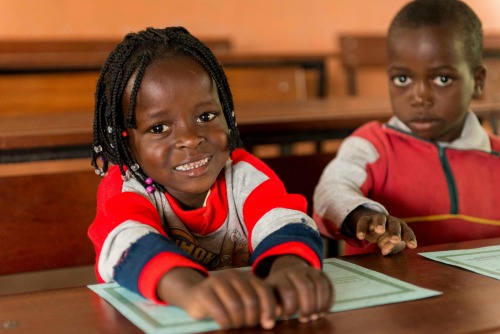
Save the Children preschool graduate, Vania, 5, from the Gaza Province in Mozambique, joined by a future classmate, gets a taste of what it will be like to sit at a real desk when she enters primary school next year. Preschoolers in her village are used to sitting on mats on the floor and were excited to sit in ‘big-kid’ chairs and desks at the nearby primary school. Photo credit: Pei Ketron for Save the Children. October 2013.
WMB: Do you see the benefits in terms of kids who have had these early intervention programs staying in school longer, and particularly for girls, marrying later or are these programs too new to tell yet?
AG: Children enrolled in preschool have a greater chance of going to school, going to school at the right age, and staying in school longer. They have higher graduation rates and are less likely to drop out of school or end up imprisoned. What’s more, staying in school is a mechanism to protect girls from early marriage. While it’s still too early to prove long-term benefits of preschool, such as that it results in girls marrying later in life, we hope to conduct such longitudinal studies in the future.
WMB: Are the children given meals through the program as an incentive for parents to send them or are the community members generally open and willing participants?
AG: It is usually not sustainable to provide meals to all children who are enrolled in preschool. Taking this into account, in most communities preschool lasts for half the school day so children can come home for meals. In some communities, parents might pool their resources in order to provide meals at preschools. In addition, preschools provide an opportunity to educate parents on how to improve nutrition for their child.
The willingness of parents to enroll their children in preschool varies from parent to parent and from community to community. Oftentimes, we’ll have a group of early adopters who are eager to enroll their children and whose success, in turn, inspires a wave of other parents–who prefer a stand-back, wait-and-see approach–to sign up their little ones.
WMB: Had you been to Mozambique before?
AG: No, this was my first time.
WMB: What is the best way people reading could support the Save the Children preschool programs in the developing world?
AG: Your readers could become a sponsor to support early childhood programs in developing countries. They could also advocate to the U.S. government to include preschool and early childhood development in its international aid programs. To learn more, visit www.savethechildren.org.
WMB: How have the mothers responded to these programs? (ie. gives them the opportunity to go to work or tend to smaller children)
AG: We encourage the participation of both mothers and fathers in their children’s education. Sending their children to preschool allows parents to tend to their daily chores, work in the field or otherwise provide for their family while knowing that their children are in good hands and are learning, to boot. In traditional societies, where childcare falls on women, preschools certainly offer an opportunity for women to engage in more productive labor and earn an additional income for their family. And we know from experience that when women earn more income for their families, they tend to invested in their children.
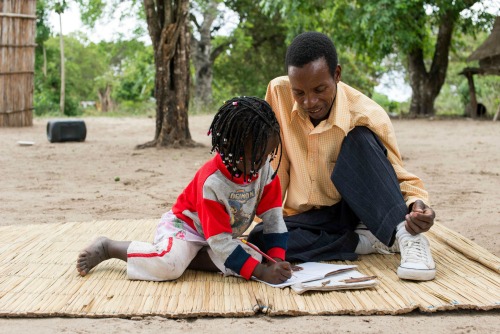
Vania, 5, practices the alphabet and counting every day with her father, Armando, who is a teacher at his daughter’s preschool, which is supported by Save the Children. Photo credit: Pei Ketron for Save the Children. October 2013.
This is an original interview and post for World Moms Blog.
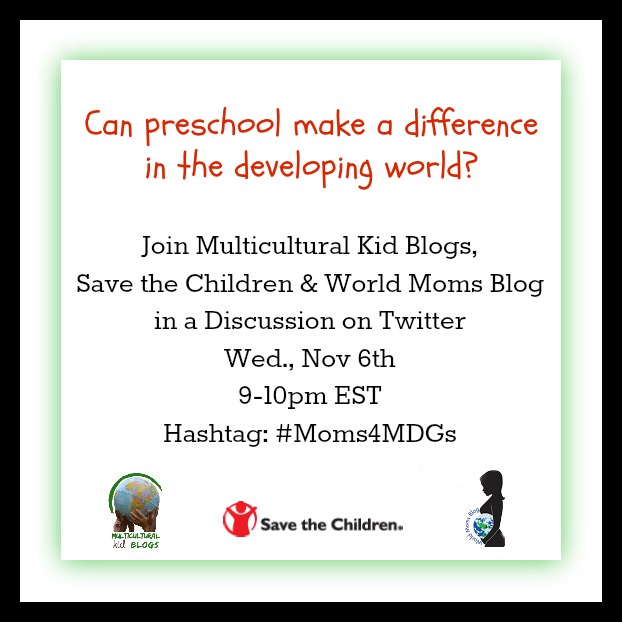

Elizabeth Atalay is a Digital Media Producer, Managing Editor at World Moms Network, and a Social Media Manager. She was a 2015 United Nations Foundation Social Good Fellow, and traveled to Ethiopia as an International Reporting Project New Media Fellow to report on newborn health in 2014. On her personal blog, Documama.org, she uses digital media as a new medium for her background as a documentarian. After having worked on Feature Films and Television series for FOX, NBC, MGM, Columbia Pictures, Warner Brothers, 20th Century Fox, and Castle Rock Pictures, she studied documentary filmmaking and anthropology earning a Masters degree in Media Studies from The New School in New York. Since becoming a Digital Media Producer she has worked on social media campaigns for non-profits such as Save The Children, WaterAid, ONE.org, UNICEF, United Nations Foundation, Edesia, World Pulse, American Heart Association, and The Gates Foundation. Her writing has also been featured on ONE.org, Johnson & Johnson’s BabyCenter.com, EnoughProject.org, GaviAlliance.org, and Worldmomsnetwork.com. Elizabeth has traveled to 70 countries around the world, most recently to Haiti with Artisan Business Network to visit artisans in partnership with Macy’s Heart of Haiti line, which provides sustainable income to Haitian artisans. Elizabeth lives in New England with her husband and four children.
More Posts
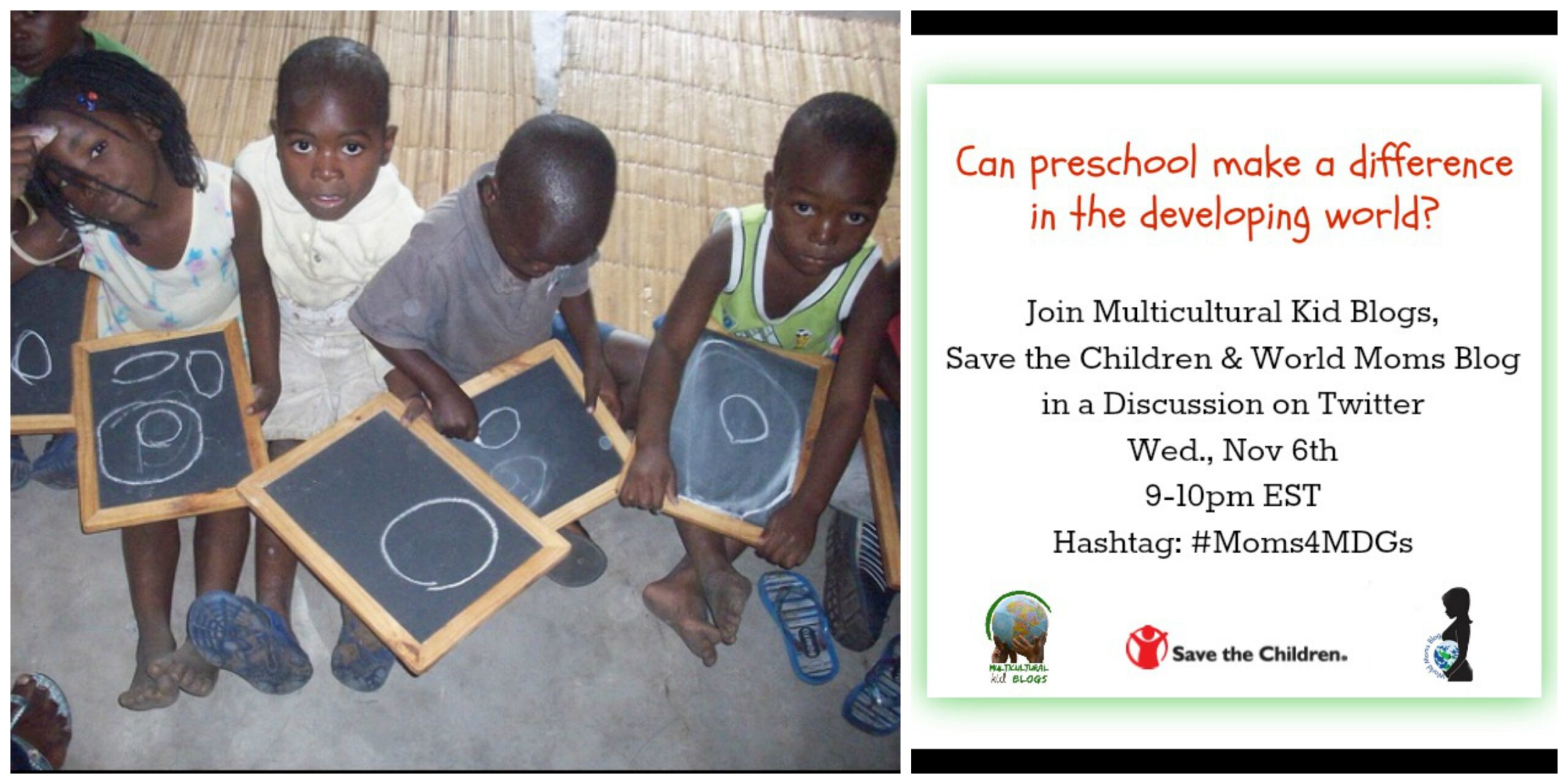
by Elizabeth Atalay | Nov 5, 2013 | 2013, Childhood, Education, Social Good, World Voice, Younger Children
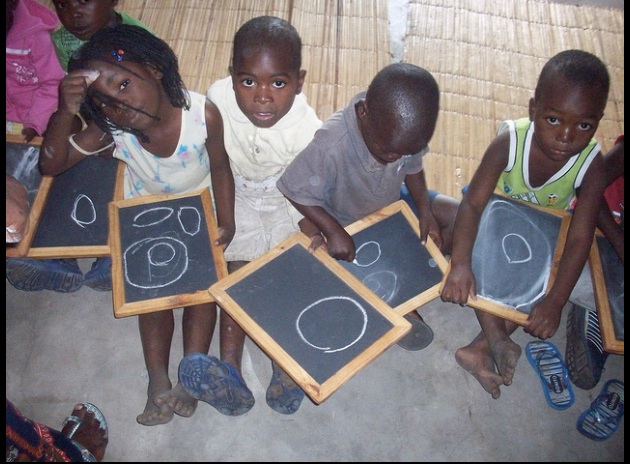
Photo Credit Save The Children
Where I live it is a given that most parents will send their kids to pre-school, some as young as two years old. It is common belief that early education builds a strong foundation for future learning, and we take for granted that our kids will go on to higher education. In other areas of the world where food security, clean water, sanitation and extreme poverty are primary concerns, education can be a luxury. In some cases in these areas it is not uncommon for an older child to begin formal primary education for the first time creating classrooms of mixed ages.
Back in 2008, a $1 million donation from the 2007 Idol Gives Back television special, helped to build escolinhas or preschool centers targeting orphans and vulnerable children for Save the Children‘s program in Mozambique. Since then the program has reached about 5,000 three to six year olds and their families, and it continues to run with the help of trained volunteers from rural communities.
Children in developing countries, like Mozambique, who attend early childhood development programs are more likely to enroll in school and enter school at the right age. This is important because children who are over-age for their grade level are more likely to drop out, so early childhood development programs actually increase the chances that children will stay in school longer.
Due to the success of the preschool centers Save The Children was able to continue to find funding, and recently the progress seen in the area caught the eye of the Government of Mozambique, resulting in the implementation of similar early childhood education programs throughout the country.
A new World Bank evaluation shows early childhood programs help children thrive and learn more in rural Africa. The recently released , is good news for children and families in Africa.-Save The Children
In a country where most inhabitants live in rural interior areas that are prone to “hungry seasons” of flooding or drought, kids enrolled in early childhood development centers benefit from access to health care and interventional care such as deworming, malaria prevention, nutritional support or social welfare.
Investment in early childhood development can provide the greatest return, and the results from these Early Learning Centers are proof. It is important to reach kids before it is too late, before they have dropped out of school, or grown up without reaching their full potential. Development aid and countries have the opportunity to make a lasting difference in health outcomes, economic productivity, and educational opportunities by investing more human and financial resources into early childhood development programs.
To find out more about early education and Save The Children’s program in Mozambique join us tomorrow night, Wednesday November 6th from 9-10pm EST for a #Moms4MDGs twitter party with Save the Children, Multicultural Kids Blogs and World Moms Blog! Hope you can make it!

This is an original post written by Elizabeth Atalay of Documama for World Moms Blog.

Elizabeth Atalay is a Digital Media Producer, Managing Editor at World Moms Network, and a Social Media Manager. She was a 2015 United Nations Foundation Social Good Fellow, and traveled to Ethiopia as an International Reporting Project New Media Fellow to report on newborn health in 2014. On her personal blog, Documama.org, she uses digital media as a new medium for her background as a documentarian. After having worked on Feature Films and Television series for FOX, NBC, MGM, Columbia Pictures, Warner Brothers, 20th Century Fox, and Castle Rock Pictures, she studied documentary filmmaking and anthropology earning a Masters degree in Media Studies from The New School in New York. Since becoming a Digital Media Producer she has worked on social media campaigns for non-profits such as Save The Children, WaterAid, ONE.org, UNICEF, United Nations Foundation, Edesia, World Pulse, American Heart Association, and The Gates Foundation. Her writing has also been featured on ONE.org, Johnson & Johnson’s BabyCenter.com, EnoughProject.org, GaviAlliance.org, and Worldmomsnetwork.com. Elizabeth has traveled to 70 countries around the world, most recently to Haiti with Artisan Business Network to visit artisans in partnership with Macy’s Heart of Haiti line, which provides sustainable income to Haitian artisans. Elizabeth lives in New England with her husband and four children.
More Posts

by Jennifer Burden | Oct 29, 2013 | 2013, Family, World Voice
Just a few months ago, I had the opportunity to tour a New Jersey, USA preschool, whose playground had been covered in sludge from Super Storm Sandy. That was the day Save the Children announced their Get Ready, Get Safe program, which advocates for emergency disaster planning for schools, preschools and day cares in the United States.
(But what about where you live? Read on for some helpful tips that can be applied anywhere on the globe…)
Today marks one year since Super Storm Sandy hit the U.S., and within the past year, our planet has experienced other natural disasters that have made their devastating impact, too, including the floods in the Philippines.
“Sandy has been toughest on children: VIDEO: Save the Children: Hurricane Sandy 1 Year Later.”
What can you do to prepare your community?
Ask your children’s school or day care center if they have an emergency preparedness plan. If not, suggest one!
What can you do to prepare your family?
Check out this graphic from Save the Children below to assist you in your family safety plan:
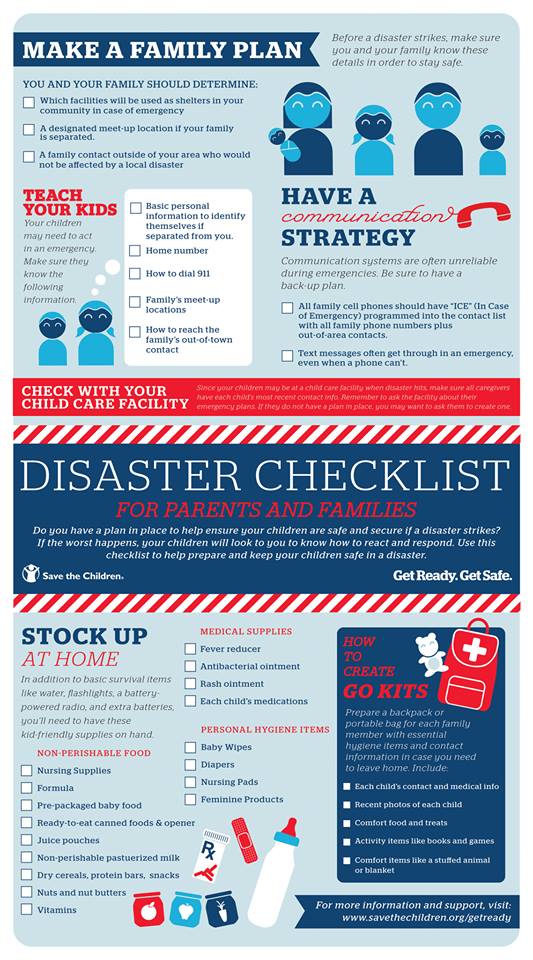
I’ve got to go now to make my “go kit.” I hope you will, too.
This is an original post to World Moms Blog by World Mom, Jennifer Burden of New Jersey, USA.
Photo credit to Save the Children.
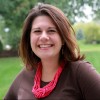
Jennifer Burden is the Founder and CEO of World Moms Network, an award winning website on global motherhood, culture, human rights and social good. World Moms Network writes from over 30 countries, has over 70 contributors and was listed by Forbes as one of the “Best 100 Websites for Women”, named a “must read” by The New York Times, and was recommended by The Times of India.
She was also invited to Uganda to view UNICEF’s family health programs with Shot@Life and was previously named a “Global Influencer Fellow” and “Social Media Fellow” by the UN Foundation. Jennifer was invited to the White House twice, including as a nominated "Changemaker" for the State of the World Women Summit. She also participated in the One Campaign’s first AYA Summit on the topic of women and girl empowerment and organized and spoke on an international panel at the World Bank in Washington, DC on the importance of a universal education for all girls. Her writing has been featured by Baby Center, Huffington Post, ONE.org, the UN Foundation’s Shot@Life, and The Gates Foundation’s “Impatient Optimists.” She is currently a candidate in Columbia University's School of International and Public Affairs in the Executive Masters of Public Affairs program, where she hopes to further her study of global policies affecting women and girls.
Jennifer can be found on Twitter @JenniferBurden.
More Posts - Website
Follow Me:


by Kristyn Zalota | Oct 22, 2013 | 2013, World Voice
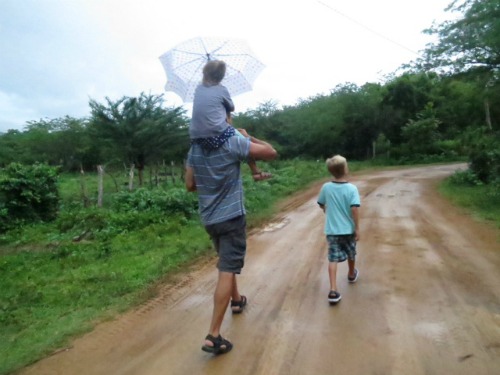
I have always joked that one day both my kids will whine in unison, “Enough with the developing world, can’t we just go to Disney?” I am pretty sure that will happen. But in the meantime, by traveling together I hope to show them that there are people in need and that we have the power to give a helping hand.
Volunteering has always been a part of my life. From a young age, I dished out food at local soup kitchens and baked and collected for drives and sales. I saw and smelled people living in my own community who didn’t have enough to eat or a place to take a shower. It wasn’t always pretty but, as a kid, I felt good knowing that I could help.
My first international volunteer experience was magical: nine months on the Thai-Lao border, as a newlywed, teaching community college students. What a life changer. It was the first of many trips that left me feeling that I got the better end of the bargain: a rich, meaningful experience, an opportunity to learn about a new place, people, and most of all, myself.
This is one of things that I want to share with my kids about volunteering: you give but you get even more. Sure you might find yourself in uncomfortable physical circumstances, but you get to experience a new place in a unique way and make human connections that will change you forever.
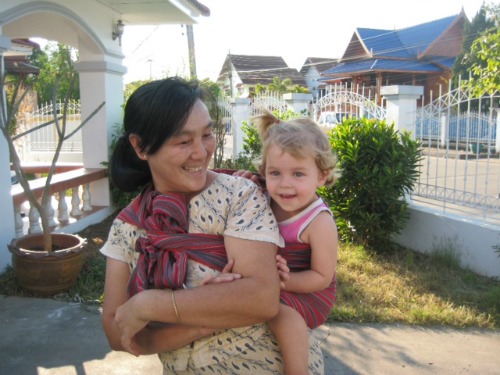
I am also ingraining in them the need to be respectful of those you are assisting.
In my work with CleanBirth.org, I face the need to balance my Northern Hemisphere take-over instinct with the knowledge that lasting change must be embraced by local people. We are indeed privileged with access to education and wealth, but we don’t have all the answers. We must keep our eyes and ears open, to really hear what people are saying and then work together to bring about positive change.
Have you volunteered with your kids? Did you feel like your family received just as much as you gave?
This is an original post by World Moms Blog contributor, Kristyn Zalota, in Guatemala.
Photo credits to the author.
Kristyn brings her years of experience as an entrepreneur and serial volunteer to CleanBirth.org. She holds a MA, has run small businesses in Russia and the US, and has volunteered in Nicaragua, Costa Rica, Thailand, Cambodia, Laos and Uganda on projects related to women’s empowerment.
After having children, Kristyn became an advocate for mothers in the US, as a doula and Lamaze educator, and abroad, as the Founder of CleanBirth.org. She is honored to provide nurses in Laos with the supplies, funding and training they need to lower maternal and infant mortality rates in their villages.
More Posts

by Jennifer Burden | Oct 12, 2013 | 2013, World Voice

#Moms4MDGs! World Moms Blog editors, Elizabeth Atalay, Jennifer Burden & Nicole Melancon pose with the ONE Campaign’s Jeannine Harvey and writer Jennifer Barbour just before heading into UN Headquarters in New York City on September 23, 2013.
In the late 1970s, a popular saying then was, “Who cares?” — equivalent to the “Whatever!”, which was more frequently used by myself and my peers decades later. Back in the day, my older teenage family members and friends would use the “Who cares?” in natural conversation when I was running around the house as a toddler. I would immediately respond by turning my head to one side and saying, “I care!” My family found this entertaining, and they kept saying, “Who cares?”, to get me to do the silly head turn. (Yep. I just admitted that.)
Too young to explain then, I still remember why I turned my head. I wanted them to know that someone cared, but I didn’t want anybody to know it was me.
Fast forward 30 something years later, and I have found a place where fellow “I Care!” folks convene. Like a Trekkie at a Star Trek conference, I was among the masses of people “Who Care” at the Social Good Summit this year, including Richard Branson, Melinda Gates (who follows World Moms Blog!), Al Gore, will.i.am and Malala.
This year was World Moms Blog’s third year in attendance at the event, which is a “three day conference where big ideas meet new media to create innovative solutions” that coincides with the UN’s General Assembly in New York City.

Nicole Morgan, Jennifer Barbour, Jeannine Harvey, Elizabeth Atalay, Kelly Pugliano and Jennifer Burden at the Social Good Summit September 24th, 2013 in NYC.
The first year in 2011, our website was less than one year old, and I attended with my husband in tow to help me watch my baby girl. I knew not a soul, and stepped out of my comfort zone to do things like introduce myself to super model Christy Turlington Burns after being inspired by her session on working alongside bloggers to improve global maternal health. I also connected further with the UN Foundation’s Shot@Life campaign, which I later traveled to Uganda with last year and the GAVI Alliance, for which we have hosted global tea parties in support of life-saving vaccines for children.
Our second year at the summit in 2012, World Moms Blog had newly made the FORBES list of “Top 100 Websites for Women 2012” for our first of two times, and I couldn’t wait to listen to and meet Moira Forbes, who heads FORBES Woman. By this time I had roped some amazing, like-minded friends from my blogging circle into the conference, too — Nicole Melancon of Third Eye Mom and Elizabeth Atalay of Documama. They are the World Voice editors at World Moms Blog and cover social good and human rights.
That year, we met some incredible people, such as Nicholas Kristoff, coauthor of “Half the Sky“, a must-read book on the nightmare realities of modern day slavery. The summit was also a great opportunity for a reunion with fellow Shot@Life Champions, whom we had met earlier that year at training in Washington, D.C. in support of global vaccines, and our fellow #ONEMoms who support eradicating global poverty.
Our third time at the Social Good Summit this past September, our World Moms Blog team expanded, and I was also thrilled to be invited as a #2030NOW “Global Influencer” Fellow by the UN Foundation and Plus Social Good.
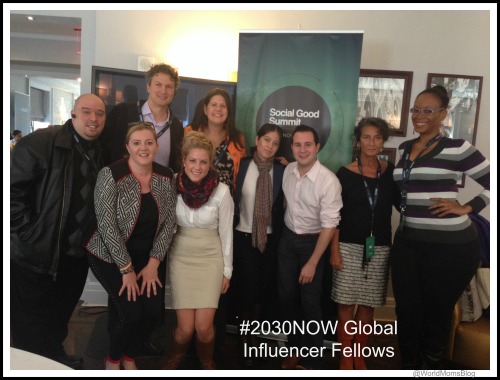
I attended small “Master Class” private sessions throughout the conference and networked with some new amazing peers. One of which was Wall Street power house, Whitney Johnson, who recently named me to her list of the few people who made a lasting impression at the Social Good Summit. I am entirely humbled. The list also includes one of my total heroes who spoke at the Social Good Summit, Malala, the brave girl in Pakistan who was shot in the face by the Taliban and addresses the world on the importance of education girls.
I also got the chance to rub elbows with the fiery Feminista Jones, who is not afraid to stand up in a room of over achievers and a princess and give an effortless tirade on why AIDS is killing black women in America at alarming rates and no one seems to care. I didn’t know if I wanted to hug or tweet her afterwards. We were discussing HIV/AIDS with HRH Mette-Marit, the Crowned Princess of Norway to add some context here.
In addition to the #2030NOW Global Influencers team, the Shot@Life Champions and #ONEMoms, I was also proud to be part of another social good posse. We’re made up of women who happen to also be moms and writers, and we all live for this helping people all over the world stuff. It’s in our blood. And it matters.
Nicole and Elizabeth came back this year, and we added Nicole Morgan, Kelly Pugliano, Jennifer Barbour and the former Miss Tanzania and Miss Africa World and current social entrepreneur, Nancy Sumari to our pack. Nancy happened to be in NYC on a work-cation, and meeting her was a total highlight!
World Moms Blog contributors took the stage at the Social Good Summit, too! LaShaun Martin spoke on the “Mothers Connect” panel with Johnson & Johnson and Shot@Life, and Nicole Morgan was asked to speak on her wishes for her children on the same panel. Well done, World Moms!
This year our normal schedule was also highlighted by additional invitations from ONE.org, WaterAid, Save the Children, Shot@Life, The Bill and Melinda Gates Foundation, Women Deliver, and the GAVI Alliance to talk social good and network outside of the summit. This included two invitations to UN Headquarters for discussions, one on Millennial Factivism with ONE.org and Okay Africa and another on Harnessing the Power of Global Public-Private Partnerships with the GAVI Alliance and the Global Fund. We have learned so much that we’ll carry along with us.
For example, at a private meeting with Mark Suzman, Managing Director of International Policy and Programs for The Bill and Melinda Gates Foundation, he gave us a stat that I have continued to turn over and over in my head ever since,
“In Ethiopia 1 in 15 children die before the age of 5 years old. But, not too long ago that statistic had been 1 in 5 children.” A true reminder that the world is making progress when it comes to the Millennium Development Goals, but there is still much work to be done.
There were internal lessons for us on gaining the self-confidence to speak up and carry out our work, too. For example, being at a press event when they’re fielding questions for Carolyn Miles, the CEO of Save the Children, about refugee children in Syria and the questions were coming from TIME Magazine, ABC and….well, World Moms Blog. (We care about kids!)
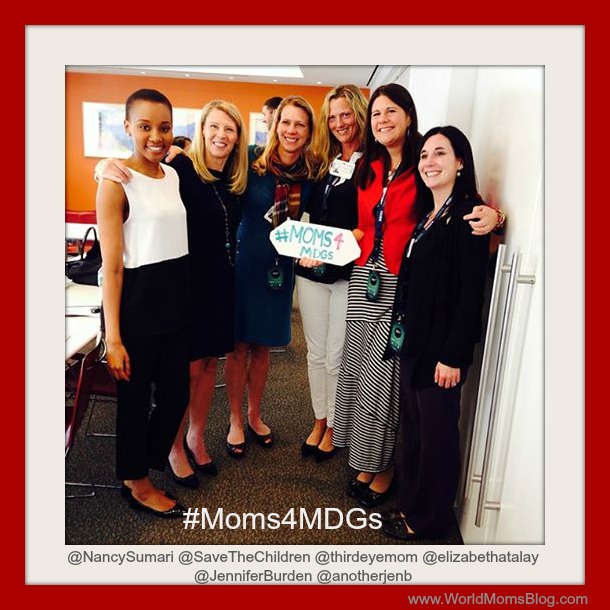
#Moms4MDGs in NYC — Nancy Sumari; Carolyn Miles, CEO of Save the Children, Nicole Melancon; Elizabeth Atalay; Jennifer Burden; and Jennifer Barbour just after a discussion on children refugees from the Syrian conflict. Sept. 23, 2013.
Or going through UN Headquarters security with fellow World Mom and Sister from Another Mister, Nicole Morgan, with our matching bright green luggage that we had both received as gifts from the Disney Social Media Moms conference amongst high level foreign diplomats.
We went from sharing a seat at the “It’s a Small World” ride together in May at Walt Disney World to being invited to the UN headquarters during the General Assembly in September. It really is a small world after all.
Our global posse is rooting together for the good of the world, and we’re also always pushing, encouraging, growing like a snowball and making it easier for each other to do more. The Social Good Summit has proved a great place to connect World Moms Blog with the United Nations and with organizations working towards a better life for mothers and children around the globe, an important part of our mission. Our contributors, in turn, are bringing big ideas to media, just like the creation of our #Moms4MDGs campaign to raise awareness for the UN’s goals to end poverty inspired by our editor, Purnima Ramakrishnan in India. I can’t wait to see what these women will do next!
And we all care very much, dammit. (Turns head to the side to stretch neck from working at the computer screen too long.)
This is an original post by World Moms Blog Founder, Jennifer Burden of NJ, USA. Keep an eye out for more from our contributors about the important global issues we were briefed on. And join our #Moms4MDGs twitter parties each month, where we talk about one global issue (UN Millennium Development Goal) per month. The next ones are October 16th, 2013 at 1pm and 9pm EST. Click our details in our sidebar, too!
Photo credits to Nicole Melancon, Elizabeth Atalay, Nancy Sumari and the #2030Now Global Influencer team!

Jennifer Burden is the Founder and CEO of World Moms Network, an award winning website on global motherhood, culture, human rights and social good. World Moms Network writes from over 30 countries, has over 70 contributors and was listed by Forbes as one of the “Best 100 Websites for Women”, named a “must read” by The New York Times, and was recommended by The Times of India.
She was also invited to Uganda to view UNICEF’s family health programs with Shot@Life and was previously named a “Global Influencer Fellow” and “Social Media Fellow” by the UN Foundation. Jennifer was invited to the White House twice, including as a nominated "Changemaker" for the State of the World Women Summit. She also participated in the One Campaign’s first AYA Summit on the topic of women and girl empowerment and organized and spoke on an international panel at the World Bank in Washington, DC on the importance of a universal education for all girls. Her writing has been featured by Baby Center, Huffington Post, ONE.org, the UN Foundation’s Shot@Life, and The Gates Foundation’s “Impatient Optimists.” She is currently a candidate in Columbia University's School of International and Public Affairs in the Executive Masters of Public Affairs program, where she hopes to further her study of global policies affecting women and girls.
Jennifer can be found on Twitter @JenniferBurden.
More Posts - Website
Follow Me:


by Nicole Melancon (USA) | Oct 8, 2013 | Third Eye Mom, World Voice
“The world has stood and watched as the children of Syria have been shot, shelled and traumatized by the horror of war. The conflict has already left thousands of children dead, and is now threatening their means of staying alive.
We understand there is a political debate over what to do next in Syria, but we believe everyone can agree on the critical need for safe humanitarian access across the entire country. There is no room for delay or argument: Syria’s children must not be allowed to go hungry.”
-Roger Hearn, Save the Children’s regional director for the Middle East.
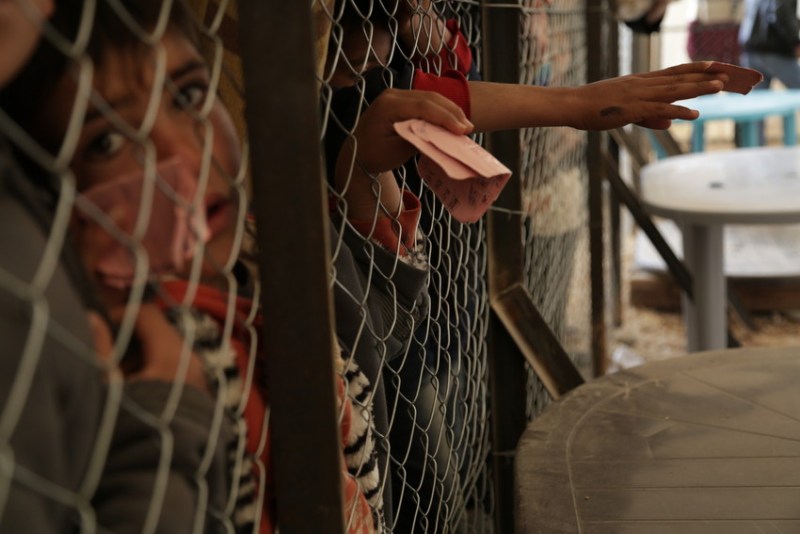
Save the Children distributes bread to residents of Za’atari refugee camp. Photo credit: Nicole Itano/Save the Children
A couple weeks ago World Mom’s Bloggers Jennifer Burden, Elizabeth Atalay, Nicole Morgan and myself attended an intimate panel hosted by Save the Children, ONE and the Bill and Melinda Gates Foundation during the 2013 Social Good Summit in New York City. It was a rare opportunity to hear some of the top social advocates and leaders speak about some of the pressing developments in social good involving eliminating extreme poverty, using technology for activism, and the current crisis in Syria.
One of the most touching conversations at the roundtable that day was listening to the President and CEO of Save the Children Carolyn Miles discuss the growing crisis in Syria and its tragic impact on its children. A week after returning from New York, I am still reflecting hard on these children and wondering how on earth I can help spread the word and raise awareness of their plight.
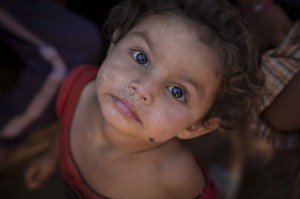
Rami*, two, at her home in a tented refugee settlement in Lebanon, near the Syrian border. *All names have been changed to protect identities. Photo Credit: Jonathan Hyams/Save the Children
The war in Syria is one of the largest humanitarian crisis of our time and sadly Syria’s most vulnerable citizens, its children, are paying the price.
On September 23rd, coinciding with the gathering of global leaders at the UN General Assembly in New York for UN Week, Save the Children released a startling report titled “Hunger in a War Zone: The Growing Crisis Behind the Syria Conflict“. I read the report and could not put it down. The images of Syria’s children still haunt me and I had to do something to spread the word about what is going on and how we can help.
Here is a summary of the key findings of the report. All information below as well as images being used with permission from Save the Children. To read the report in full, click here.
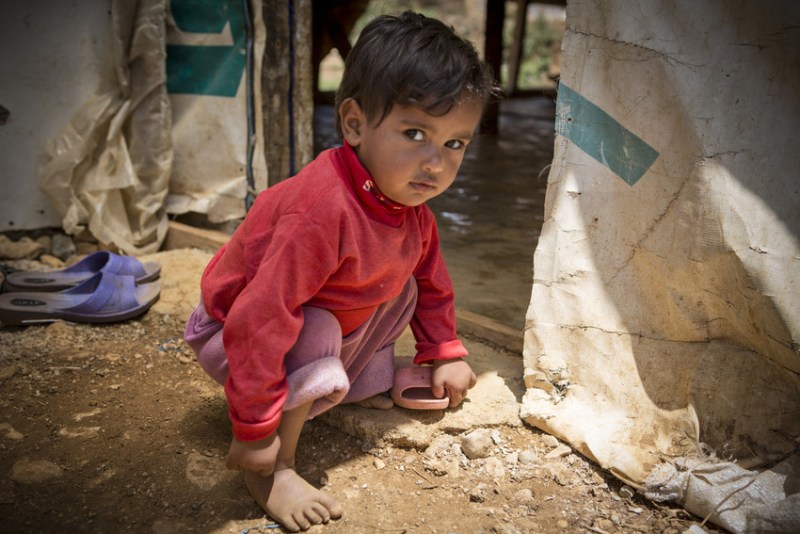
Zeina *, two, at her home in a tented refugee settlement in Lebanon, near the Syrian border. Zeina and her family are living in a small tent on the Syrian border. The father, Ahmad, has been part of Save the Children as Cash for Work programme, and used the money on food and water for the whole family. Thousands of children and their families continue to stream into neighbouring countries. Most of those who have escaped are living in makeshift shelters, unsuitable buildings or in overcrowded camps, amid growing shortages of food, medicine and water. * Names have been changed to protect identities. Photo Credit: Jonathan Hyams/Save the Children
Pictures tell a story. They show the world the people who are really suffering in Syria. Its most innocent and vulnerable: Their children.
This is the photo that struck a chord in my heart. She could be my own daughter. Same age. Same love for stuffed animals. But no smile to greet the day.
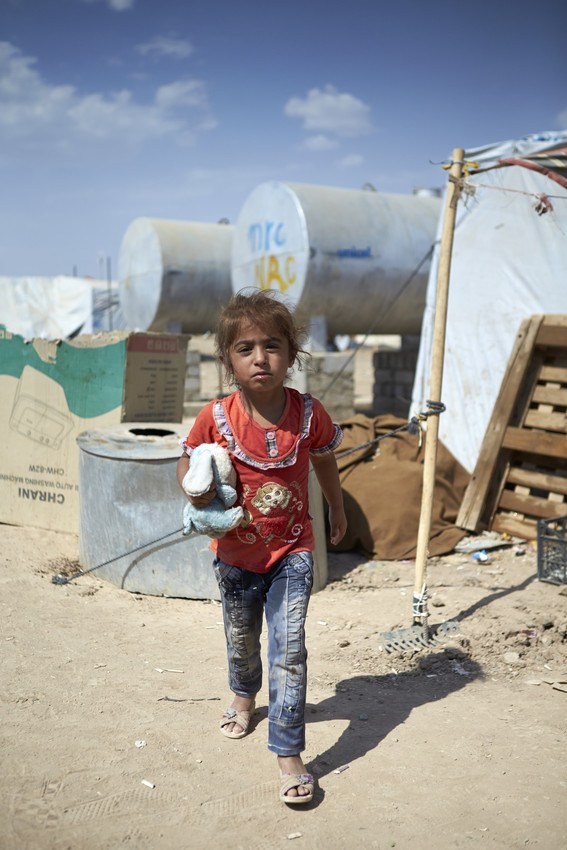
Refugee child in Iraq. Most of the refugees did not manage to bring any belongings with them when they fled Syria. Some children managed to save their favourite teddy bear or doll. Others have received new toys after moving to the camp. Photo Credit: Rob Holden/Save the Children
It is hard to look at these photographs and not feel some inherent urge to jump on a plane and save them. As a mother of two children, ages 6 and 8, I cannot even begin to imagine what it must be like for these parents and their children.
In mid-September, it was estimated that there are over 4 million displaced families living inside of Syria’s borders in temporary housing with little access to food to feed their children and barely a drip of water. Another two million have fled the country pouring into neighboring countries such as Jordan, Lebanon, Turkey, Iraq, and Egypt at a rate of nearly 6,000 day*.
Some families are living in abandoned industrial buildings while others in makeshift refuge camps. The World Health Organization has deemed the crisis in Syria “to be one of the worst ongoing humanitarian crisis on earth”. As the sun begins to turn cold and food becomes more and more scarce, what will these families feed their growing, hungry children?
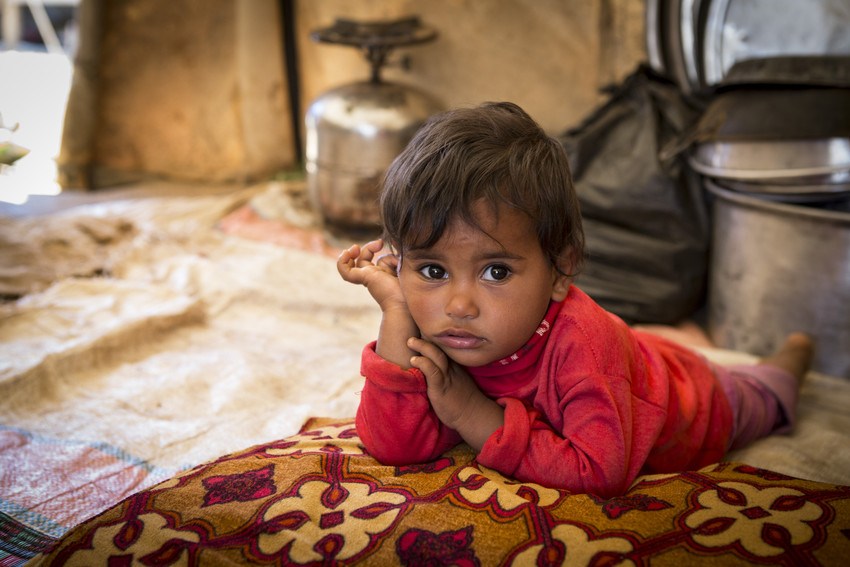
Zeina *, two, at her home in a tented refugee settlement in Lebanon, near the Syrian border. *Names have been changed to protect identities. Photo credit: Jonathan Hyams/Save the Children
Per Save the Children, “More than four million Syrians — more than two million of them children — are unable to produce or buy enough food, with many thousands living under fire and with no access to all but the bare minimum foodstuffs needed to survive. Save the Children is already seeing reports that one in 20 children in rural Damascus is severely malnourished”.**
One of the biggest issues right now is the fact that most of Syria’s families are trapped in dangerous locations where they have little or no access to food. They are faced with making the unimaginable decision. To stay inside their homes and starve or to face bullets and death by leaving the safety of their homes to get food for their family. It is a choice no parent should have to make.
“A message to the World”
“This is a message from the Syrian people to world leaders. I am 13 years old and I am Syrian. I am Ali. I want to talk about the tragedy that we have in Syria. In Syria, we have no good food and not enough water. We only have lentils. So we ate lentils every day. We would see wounded people and dead bodies every day in the street, and many children who did not have homes. They are living in schools. But now they don’t even have a school to live in. I am asking the leaders of the world to provide us safe shelter, food, water, medicine – this is all we ask. Please, please, please – help us”.
-Ali, 13 years old***
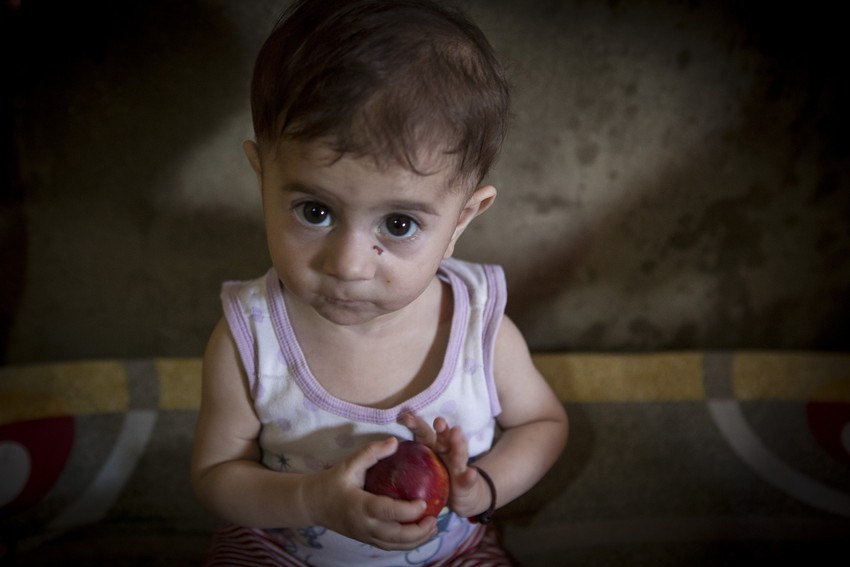
Maya * 11 months, at her home in a disused industrial building in Lebanon near the Syrian border *All names have been changed to protect identities. Photo credit: Jonathan Hyams/Save the Children
Another issue is that the war has destroyed Syria’s economy pulling a once relatively prosperous country into shambles. The United Nations “now estimates close to seven million inhabitants have been plunged into poverty since fighting began. In addition, Syria’s agriculture and infrastructure are collapsing, with grain production falling to less than half of what was typical before the war”**. Furthermore, “after two and a half years of war, the conflict has set Syria back 35 years and imposted an economic cost of more than $84 billion, equivalent to over 140 % of Syria’s pre-war GDP”. *** Once the war ends, rebuilding is going to be a long and painful journey.

Nadia *, one and a half, is carried by her mother Roula * outside their home in a tented refugee settlement in Lebanon, near the Syrian border. *Names have been changed to protect identities. Photo Credit: Jonathan Hyams/Save the Children
What Save the Children is asking world leaders is to secure humanitarian access to the people per Save the Children’s Carolyn Miles. There are 7 million people in need of assistance and 5 million people stuck inside the country. Save the Children strongly believes that regardless of the political situation in Syria, we must do something about this enormous humanitarian crisis. We must act and we must act now. Time is running out for the millions of children and families who are suffering and facing extreme hunger and malnutrition. The world must listen and help.
Here is a link to what needs to be done. (See page 19)
Here is the latest response by global leaders: Press Release 10/02/13 Save the Children “UN Aid Access Agreement Could Save Thousands of Lives in Syria”.
The fight to save Syria’s children is far from over. We need to act now and spread the word. We need to voice our concern.
This is what is at stake: Children.

Suhad * six, lies on the floor of her home in a tented refugee settlement in Lebanon, near the Syrian border. *Names have been changed to protect children’s identities. Jonathan Hyams/Save the Children
Related Posts and References:
*“Six Million Displaced by War in Syria” via the Atlantic
**Food Shortages Put Syria’s Children at Risk of Malnutrition
***Hunger in a War Zone: The Growing Crisis Behind the Syria Conflict“
Highlights from the 2013 Social Good Summit
To keep in touch with the latest updates on Save the Children’s work in Syria and how you can help, click here.
How can the world sit by and watch these children suffer?
This post was written and modified for World Moms Blog by Nicole Melancon who can also be found at ThirdEyeMom.

Third Eye Mom is a stay-at-home mom living in Minneapolis, Minnesota with her two children Max (6) and Sophia (4). Her children keep her continually busy and she is constantly amazed by the imagination, energy and joy of life that they possess! A world wanderer at heart, she has also been fortunate to have visited over 30 countries by either traveling, working, studying or volunteering and she continues to keep on the traveling path.
A graduate of French and International Relations from the University of Wisconsin Madison, where she met her husband Paul, she has always been a Midwest gal living in Minnesota, Wisconsin and Chicago. This adventurous mom loves to be outside doing anything athletic (hiking, running, biking, skiing, snowshoeing or simply enjoying nature), to travel and volunteer abroad, to write, and to spend time with her beloved family and friends.
Her latest venture involves her dream to raise enough money on her own to build and open a brand-new school in rural Nepal, and to teach her children to live compassionately, open-minded lives that understand different cultures and the importance of giving back to those in need. Third Eye Mom believes strongly in the value of making a difference in the world, no matter how small it may be. If there is a will, there is a way, and that anything is possible (as long as you set your heart and mind to it!).
Visit her on her blog, Thirdeyemom, where she writes about her travels and experiences in other lands!
More Posts































